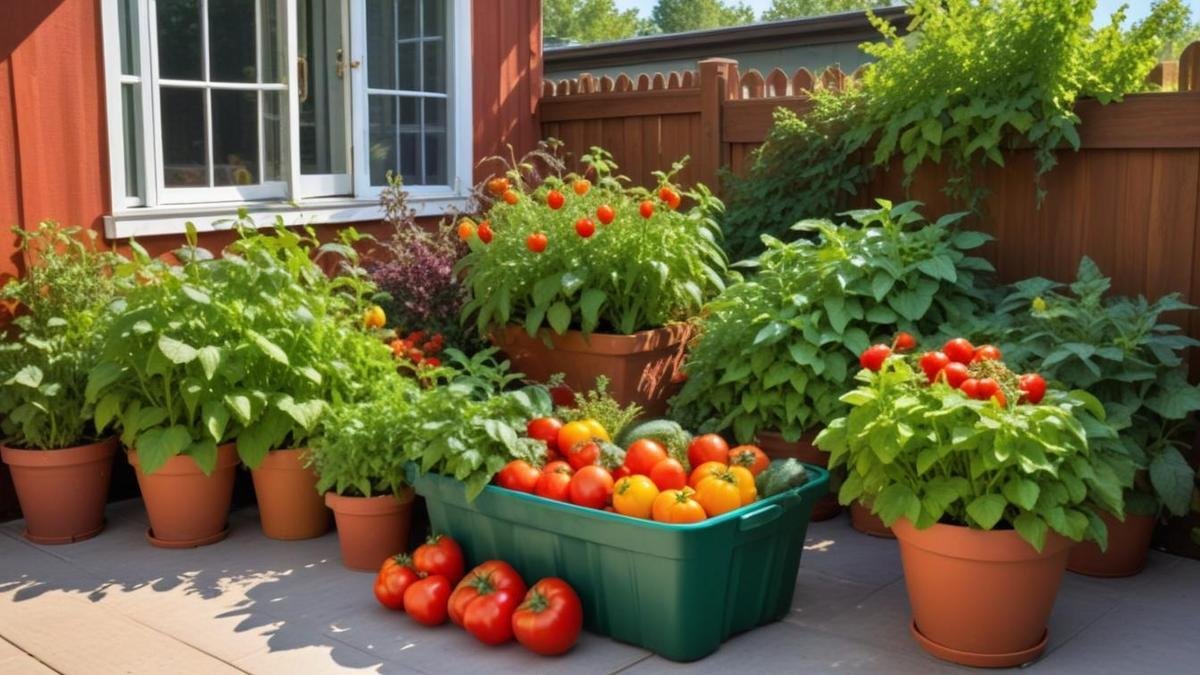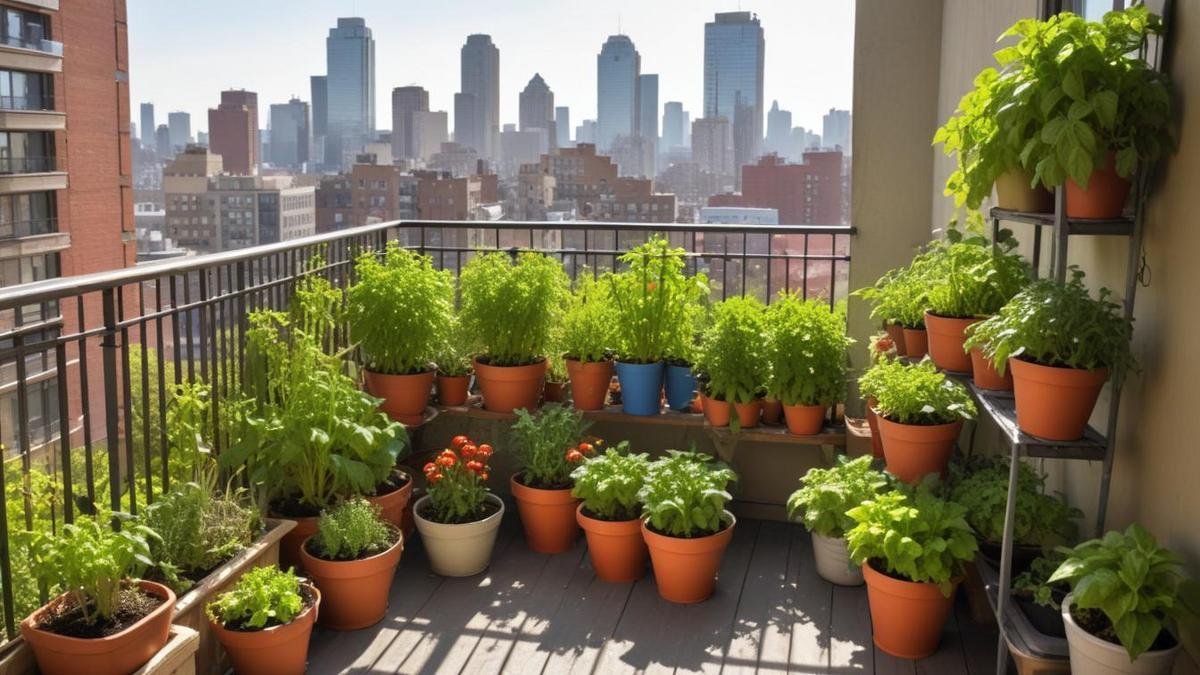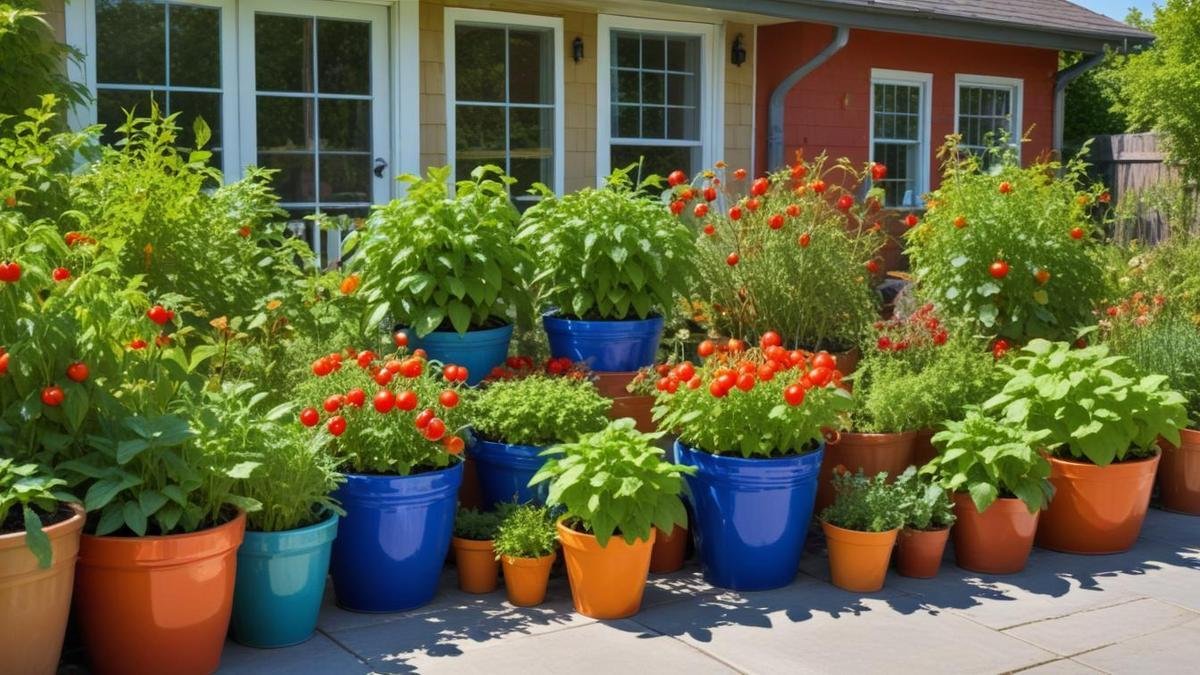
Are you ready to discover the best vegetables to grow in containers during summer? If you love fresh veggies but lack a big garden, don’t worry! Container gardening is the perfect solution for you. It’s easy, fun, and a great way to use small spaces creatively. Get set for some simple tips and tricks to make your summer garden thrive!
Important Points
- You can grow tomatoes in containers for fresh summer salads.
- Peppers are easy to grow and add spice to your meals.
- Cucumbers thrive in containers and are great for snacks.
- Herbs like basil and parsley are perfect for small spaces.
- Lettuce grows quickly and is perfect for summer salads.

Top Picks for Best Vegetables to Grow in Containers During Summer
Easy Vegetables to Grow in Pots
Growing vegetables in pots is a breeze! Here are some easy choices that you can try this summer:
- Lettuce: Fast-growing and perfect for salads. Just keep it watered!
- Radishes: They sprout quickly and are fun to harvest.
- Cherry Tomatoes: Sweet and juicy, they love the sun.
- Spinach: Grows well in containers and is packed with nutrients.
- Herbs: Basil, parsley, and cilantro are great options for flavor.
Heat-Tolerant Plants for Containers
When the sun is blazing, you want plants that can handle the heat. Here are some heat-tolerant veggies:
- Peppers: From sweet to spicy, they thrive in warm weather.
- Eggplants: They love the sun and are perfect for grilling.
- Okra: This southern favorite loves hot temperatures.
- Zucchini: Quick to grow and produces a lot!
- Sweet Potatoes: They can handle the heat and are delicious too.
Why These Vegetables Thrive in Summer
These vegetables are like the champions of summer gardening! They love the warm weather and can handle the heat. Their roots grow deep, helping them find moisture in the soil. Plus, many of them grow quickly, so you can enjoy fresh veggies in no time.
| Vegetable | Sunlight Needed | Days to Harvest |
|---|---|---|
| Lettuce | 6-8 hours | 30-60 |
| Cherry Tomatoes | 6-8 hours | 60-80 |
| Peppers | 6-8 hours | 70-90 |
| Zucchini | 6-8 hours | 50-70 |
| Sweet Potatoes | 6-8 hours | 90-120 |
Container Gardening Tips for Summer Success
Choosing the Right Containers
When you’re diving into container gardening, the right container is key. You want to pick something that suits your plants. Here’s what to consider:
- Size: Bigger is often better. Larger containers hold more soil, which helps retain moisture.
- Material: Options include plastic, clay, or ceramic. Plastic is lightweight, while clay is more breathable.
- Drainage: Ensure your container has holes at the bottom. This helps excess water escape, preventing root rot.
| Material | Pros | Cons |
|---|---|---|
| Plastic | Lightweight, cheap | Can heat up quickly |
| Clay | Breathable, sturdy | Heavy, can crack |
| Ceramic | Attractive, durable | Heavy, expensive |
Soil and Watering Needs
Now that you have your containers, let’s talk about soil and watering. Good soil is like a cozy bed for your plants. Here’s what to keep in mind:
- Soil Type: Use a potting mix instead of garden soil. Potting mix drains well and is light.
- Watering: During summer, your containers will need more water. Check daily. If the top inch of soil is dry, it’s time to water.
Best Practices for Container Gardening
To keep your plants thriving, follow these best practices:
- Sunlight: Most veggies need 6-8 hours of sunlight daily. Place your containers in a sunny spot.
- Fertilizing: Use a balanced fertilizer every few weeks. This helps your plants grow strong.
- Mulching: Add a layer of mulch on top of the soil. This keeps moisture in and weeds out.
By following these tips, you’ll be on your way to a bountiful summer garden. Remember, the best vegetables to grow in containers during summer include tomatoes, peppers, and herbs. These veggies love the warmth and can thrive in smaller spaces.

Space-Saving Vegetable Gardening Ideas
Vertical Gardening Techniques
If you’re tight on space, vertical gardening is your best friend! This technique lets you grow plants upwards instead of outwards. Here are some ideas to get you started:
- Trellises: Use a trellis for climbing plants like peas and cucumbers. They’ll grow tall and free up ground space.
- Wall Planters: Attach planters to your walls. Herbs and small vegetables can thrive here.
- Hanging Baskets: Hang baskets from your porch or balcony. Strawberries and cherry tomatoes love this setup!
Using Small Spaces Wisely
Every inch counts when you’re gardening in small areas. Here are some tips to make the most of your limited space:
- Choose Compact Varieties: Look for dwarf or compact versions of your favorite vegetables. They take up less room and still produce plenty.
- Interplanting: Grow different plants close together. For example, pairing lettuce with radishes can maximize your garden’s output.
- Succession Planting: Plant new seeds as soon as you harvest. This keeps your garden productive all season long.
Maximizing Your Container Garden Space
Containers are a great way to garden, especially if you lack a yard. Here’s how to make the most of your container garden:
| Tip | Description |
|—————————–|———————————————————–|
| Choose the Right Size | Use larger containers for deep-rooted plants like tomatoes. Smaller pots work for herbs. |
| Use Quality Soil | Good soil helps your plants grow strong and healthy. Mix in compost for extra nutrients. |
| Group Containers | Place pots close together. This creates a mini garden and helps keep moisture in. |
| Rotate Plants | Change what you plant each season. This keeps pests away and helps the soil stay healthy. |
Urban Gardening: Summer Vegetables for City Dwellers
Best Vegetables for Container Gardening in Urban Areas
If you’re living in the city, you might think gardening is out of reach. But guess what? You can still dig in! Here are some best vegetables to grow in containers during summer that thrive in small spaces:
| Vegetable | Days to Harvest | Container Size |
|---|---|---|
| Cherry Tomatoes | 60-80 days | 5 gallons |
| Radishes | 25-30 days | 1 gallon |
| Lettuce | 30-60 days | 1-2 gallons |
| Bell Peppers | 70-90 days | 3-5 gallons |
| Spinach | 30-45 days | 1-2 gallons |
These veggies are perfect for your balcony, patio, or even a sunny windowsill. They don’t need much space and can grow happily in pots.
Adapting to Limited Sunlight
Living in a city often means dealing with limited sunlight. But don’t let that dim your gardening dreams! Here are some tips to help you grow even if the sun is playing hide and seek:
- Choose Shade-Tolerant Plants: Look for veggies like leafy greens and herbs. They can handle less sunlight.
- Use Reflective Surfaces: Place containers near walls or fences that reflect light. This can give your plants a little extra sunshine.
- Rotate Your Pots: Move your containers around to catch the best light throughout the day.
Urban Gardening Challenges and Solutions
Every gardener faces challenges, and urban gardening is no different. Here are some common issues and how to tackle them:
| Challenge | Solution |
|---|---|
| Limited Space | Use vertical gardening or stackable pots. |
| Poor Soil Quality | Invest in quality potting mix. |
| Pests | Use natural pest repellents like neem oil. |
| Watering Issues | Consider self-watering containers. |
By being aware of these challenges, you can find ways to overcome them and keep your garden thriving.

Summer Crops for Pots: What to Plant
Fast-Growing Summer Vegetables
When summer rolls around, you want to fill your pots with fast-growing vegetables. These beauties will give you a quick harvest and keep your garden thriving. Here are some of the best vegetables to grow in containers during summer:
| Vegetable | Days to Maturity | Ideal Pot Size |
|---|---|---|
| Radishes | 25-30 days | 6-8 inches |
| Lettuce | 30-45 days | 10-12 inches |
| Spinach | 30-40 days | 10-12 inches |
| Green Beans | 50-60 days | 12-14 inches |
| Zucchini | 50-60 days | 14-16 inches |
These veggies grow quickly and can be enjoyed in salads, stir-fries, or on their own. Just remember to water them regularly and give them some sunshine!
Succession Planting for Continuous Harvest
If you want to keep the harvest coming, succession planting is your best friend. This means planting new seeds every few weeks. This way, you won’t have all your veggies ready at once, and you can enjoy fresh produce all summer long.
Here’s a simple plan:
- Start with radishes. Plant them every two weeks.
- After the first batch, plant some lettuce.
- Next up, add spinach a couple of weeks later.
By staggering your planting, you’ll have a steady supply of fresh veggies. It’s like having a garden that keeps on giving!
Planning Your Summer Crop Rotation
Crop rotation is key to keeping your garden healthy. It helps prevent pests and diseases. Here’s how to plan your summer crop rotation:
- Group your plants. Keep similar plants together. For example, put all your leafy greens in one spot.
- Rotate each season. Next year, move those leafy greens to a different spot.
- Use a calendar. Mark when you plant and harvest. It’ll help you remember where everything goes.
| Season | Plant Type | Next Season Plant |
|---|---|---|
| Summer | Leafy Greens | Nightshades |
| Fall | Nightshades | Root Vegetables |
| Winter | Root Vegetables | Leafy Greens |
By planning this way, you’ll keep your pots thriving and your veggies healthy.
Benefits of Growing Vegetables in Small Spaces
Fresh Produce at Your Fingertips
Growing your own vegetables means you can enjoy fresh produce right from your backyard or balcony. Imagine stepping outside and picking a ripe tomato or crisp lettuce for your salad. It’s like having a mini grocery store at your fingertips! You’ll save money, and the taste will be far better than store-bought veggies. Plus, you know exactly how they were grown—no hidden chemicals or pesticides here!
Environmental Benefits of Container Gardening
Container gardening is not just good for you; it’s also great for the planet. By growing your own food, you reduce the need for transportation and packaging, which cuts down on pollution. Here are some key benefits:
| Benefit | Description |
|---|---|
| Less Waste | Fewer plastic bags and containers from the store. |
| Reduced Carbon Footprint | Less fuel used to transport food. |
| Biodiversity | Encourages more varieties of plants in urban areas. |
How Container Gardening Supports Sustainability
Container gardening is a fantastic way to practice sustainability. You can use recycled materials for your pots, like old buckets or even wine crates. This method also allows you to control water usage better, which is key in our changing climate. By growing your own food, you’re playing your part in saving the environment. It’s like planting a little piece of hope for the future!
Frequently Asked Questions
What are the best vegetables to grow in containers during summer?
The best vegetables to grow in containers during summer include tomatoes, peppers, cucumbers, and lettuce. They’re easy to manage and thrive in warm weather.
How much sun do these vegetables need?
Most of these veggies need at least 6-8 hours of sunlight daily. Find a sunny spot on your porch or balcony!
Can I use any container for planting?
You can use almost any container! Just make sure it’s big enough and has holes for drainage.
How often should I water my container vegetables?
Water them regularly! Aim for every day or every other day, especially in hot weather. Check the soil; it should be moist but not soggy.
Will these vegetables grow well in small containers?
Yes, but some need larger containers! Always check the space requirements for each vegetable to ensure they have enough room to grow.
